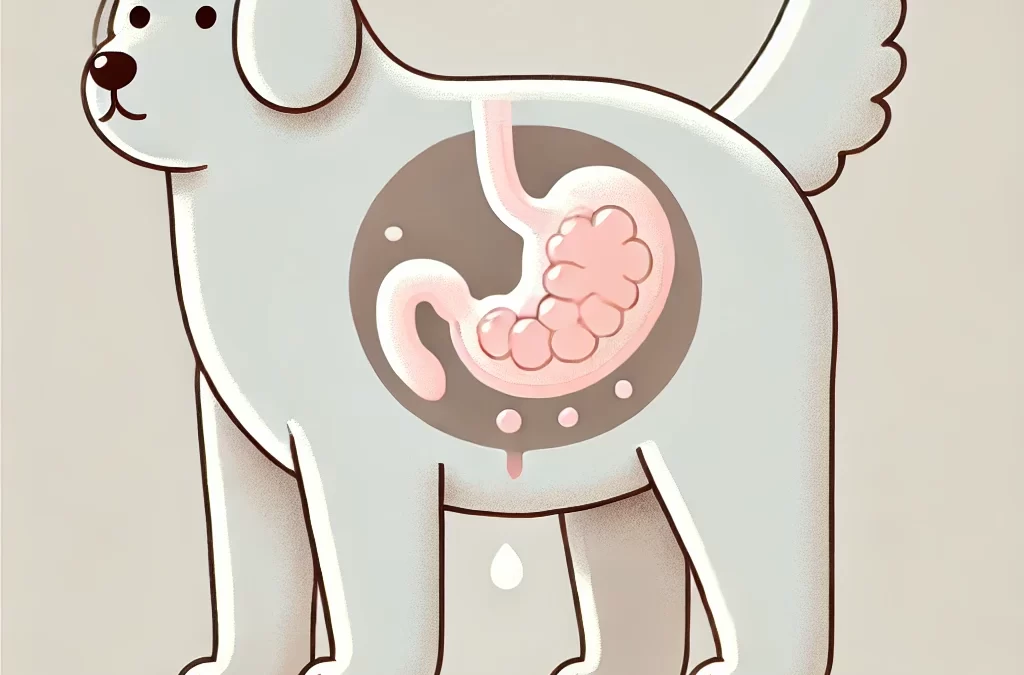
von TCMVET | 9. Dez. 2024 | Krebs und Tumore bei Hunden
Wirbelsäulentumore bei Hunden sind zwar selten, können aber ihre Mobilität und Lebensqualität stark beeinträchtigen. Diese Tumoren können sich innerhalb oder um die Wirbelsäule herum entwickeln und die Funktion des Nervensystems beeinträchtigen. Früherkennung und richtige Behandlung sind entscheidend, um Ihrem pelzigen Freund die beste Pflege zukommen zu lassen. Hier finden Sie einen umfassenden Leitfaden zu den Arten von Wirbelsäulentumoren bei Hunden und ihren Symptomen, Ursachen und Behandlungsmöglichkeiten.
Häufige Arten von Wirbelsäulentumoren bei Hunden
- Intramedulläre Tumoren
- Beschreibung: Diese Tumoren entstehen im Rückenmark selbst. Sie entstehen oft aus Gliazellen, die das Nervensystem unterstützen.
- Beispiele: Astrozytome, Ependymome und Oligodendrogliome
- Symptome: Allmähliche Schwäche, Koordinationsstörungen und in schweren Fällen mögliche Lähmung
- Behandlung: Operation (falls möglich), Strahlentherapie und unterstützende Pflege
- Extradurale Tumoren
- Beschreibung: Diese Tumoren treten außerhalb des Rückenmarks, aber innerhalb des Wirbelkanals auf, wo sie häufig das Rückenmark komprimieren und neurologische Probleme verursachen.
- Beispiele: Osteosarkome, Fibrosarkome und Lymphome
- Symptome: Rückenschmerzen, Schwierigkeiten beim Gehen und Muskelschwäche
- Behandlung: Chirurgische Entfernung, Chemotherapie oder Bestrahlung, je nach Tumorart
- Intradurale-extramedulläre Tumoren
- Beschreibung: Diese Tumoren liegen im Wirbelkanal, aber außerhalb des Rückenmarks und wachsen in den umliegenden Hirnhäuten oder Nervenwurzeln.
- Beispiele: Meningiome, Nervenscheidentumoren (Schwannome)
- Symptome: Schmerzen, Koordinationsstörungen und mögliche Harn- oder Stuhlinkontinenz
- Behandlung: Chirurgie und Strahlentherapie
- Wirbeltumoren
- Beschreibung: Diese Tumoren entstehen in den Knochen der Wirbelsäule und verursachen strukturelle Instabilität und mögliche Kompression des Rückenmarks.
- Beispiele: Osteosarkom, Chondrosarkom
- Symptome: Starke Schmerzen, Schwellungen und Schwierigkeiten beim Stehen oder Gehen
- Behandlung: Operation, Chemotherapie und Schmerzbehandlung
Symptoms of Spinal Tumors in Dogs
Die Symptome von Wirbelsäulentumoren können je nach Lage und Größe des Tumors unterschiedlich sein. Zu den häufigsten Anzeichen gehören jedoch:
- Widerwillen, sich zu bewegen oder zu spielen
- Schwierigkeiten beim Gehen oder beim Hinterherschleifen der Gliedmaßen
- Schmerzen oder Empfindlichkeit im Rücken oder Nacken
- Verlust der Blasen- oder Darmkontrolle
- Plötzliche Verhaltens- oder Haltungsänderungen
Ursachen und Risikofaktoren
Wirbelsäulentumore bei Hunden können folgende Ursachen haben:
- Genetische Veranlagung: Bestimmte Rassen wie Deutsche Schäferhunde und Golden Retriever könnten einem höheren Risiko ausgesetzt sein.
- Age: Bei älteren Hunden ist die Wahrscheinlichkeit höher, dass sie Wirbelsäulentumoren entwickeln.
- Krebsmetastasen: Tumore aus anderen Körperteilen können sich auf die Wirbelsäule ausbreiten.
Diagnose und Behandlung
Tierärzte verwenden verschiedene Methoden zur Diagnose von Wirbelsäulentumoren:
- Neurologische Untersuchung: Bewertet Reflexe, Koordination und Schmerzreaktion.
- Bildgebung: Röntgenaufnahmen, MRT oder CT-Scans zur Lokalisierung und Beurteilung des Tumors.
- Biopsie: Bestätigt den Tumortyp für eine gezielte Behandlung.
Zu den Behandlungsmöglichkeiten gehören:
- Operation: Die bevorzugte Methode bei zugänglichen und operablen Tumoren.
- Strahlentherapie: Wird bei inoperablen oder verbleibenden Tumoren nach einer Operation verwendet.
- Chemotherapie: Wirksam bei einigen metastasierten oder primären Wirbelsäulentumoren.
- Schmerztherapie: Unverzichtbar für die Verbesserung der Lebensqualität des Hundes.
Unterstützen Sie Ihren Hund bei der Genesung
Die Pflege von Hunden mit Wirbelsäulentumoren sollte Folgendes umfassen:
- Bereitstellung eines weichen, stützenden Bettes zur Vorbeugung von Druckgeschwüren
- Unterstützung der Mobilität durch Gurte oder Karren
- Eine nährstoffreiche Ernährung zur Unterstützung der allgemeinen Gesundheit
- Regelmäßige Nachuntersuchungen beim Tierarzt, um den Fortschritt zu überwachen
Abschluss
Wirbelsäulentumore bei Hunden erfordern sofortige Aufmerksamkeit und spezielle Pflege. Während die Prognose von der Art und dem Fortschreiten des Tumors abhängt, haben Fortschritte in der Veterinärmedizin die Behandlungen wirksamer gemacht. Wenn Sie die Symptome und verfügbaren Optionen verstehen, können Sie sicherstellen, dass Ihr Hund die beste Pflege und Unterstützung erhält.

von TCMVET | 9. Dez. 2024 | Krebs und Tumore bei Hunden
Die Hautgesundheit von Hunden ist oft ein Spiegel ihres allgemeinen Wohlbefindens, doch manche Erkrankungen können selbst den aufmerksamsten Tierhaltern Rätsel aufgeben. Eine dieser seltenen Erkrankungen ist verhornende Epitheliome, eine Art gutartiger Hauttumor, der aufgrund seines Aussehens und seiner Auswirkungen Anlass zur Sorge geben kann. Lassen Sie uns tiefer in diese ungewöhnliche dermatologische Erkrankung eintauchen, ihre Ursachen, Behandlungen und was sie zu einer einzigartigen Herausforderung in der Hundegesundheitspflege macht.
Was sind verhornende Epitheliome?
Verhornende Epitheliome sind gutartige Tumoren, die aus den Talgdrüsen stammen, genauer gesagt aus dem Epithel (Hautzellen), das für die Keratinproduktion verantwortlich ist. Diese Tumoren treten häufig als knotige, warzenartige Wucherungen auf der Haut eines Hundes auf. Obwohl sie nicht lebensbedrohlich sind, sollten sie aufgrund ihres Potenzials, Beschwerden oder Infektionen zu verursachen, nicht ignoriert werden.
Was verursacht verhornende Epitheliome?
Die genaue Ursache für verhornende Epitheliome ist noch nicht vollständig geklärt. Zu den möglichen beitragenden Faktoren zählen jedoch:
- Genetische Veranlagung: Rassen wie Cocker Spaniels, Beagles und Siberian Huskies neigen eher zur Entwicklung dieser Wucherungen.
- Hormonelle Ungleichgewichte: Die Talgdrüsenaktivität kann durch hormonelle Veränderungen, insbesondere bei älteren Hunden, beeinflusst werden.
- Ernährungsmängel: Eine schlechte Ernährung kann zu einem Ungleichgewicht der Hautgesundheit führen und möglicherweise Erkrankungen wie Epitheliome verschlimmern.
Die Symptome erkennen
Verhornende Epitheliome treten typischerweise wie folgt auf:
- Kleine, feste Knötchen mit warzenartiger Struktur
- Gelbliche oder wachsartige Farbe aufgrund von Keratinablagerungen
- Lokalisiert um Kopf, Hals oder Rücken, kann aber überall auftreten
- Gelegentlich begleitet von Rötung oder Entzündung, wenn eine Sekundärinfektion auftritt
Obwohl diese Wucherungen gutartig sind, sollten schnelle Veränderungen der Größe, Farbe oder Beschaffenheit von einem Tierarzt untersucht werden, um bösartige Tumore auszuschließen.
Diagnose von verhornenden Epitheliomen
Die Diagnose umfasst normalerweise:
- Körperliche Untersuchung: Ein Tierarzt wird die Größe, Lage und das Aussehen der Wucherungen beurteilen.
- Feinnadelaspiration (FNA): Um die Art des Tumors zu bestätigen, wird eine Zellprobe entnommen und analysiert.
- Biopsie: In manchen Fällen kann eine Biopsie notwendig sein, um zwischen gutartigen Epitheliomen und anderen Hauterkrankungen oder Krebsarten zu unterscheiden.
Behandlungsmöglichkeiten
Die Behandlung hängt vom Schweregrad und den Auswirkungen der Epitheliome auf die Lebensqualität Ihres Hundes ab.
- Überwachung
Bei kleinen, unproblematischen Wucherungen ist eine regelmäßige Kontrolle oft ausreichend.
- Stellen Sie sicher, dass der Bereich sauber und frei von Infektionen bleibt.
- Verwenden Sie beruhigende lokale Behandlungen, wenn Ihr Tierarzt dies empfiehlt.
- Operative Entfernung
Wenn die Wucherungen Beschwerden, wiederkehrende Infektionen oder kosmetische Probleme verursachen, ist die chirurgische Entfernung eine häufige Lösung.
- Minimalinvasive Techniken wie die Laserchirurgie können die Genesungszeit verkürzen.
- Topische oder systemische Therapien
- Retinoide oder Vitamin-A-Ergänzungsmittel können die Keratinproduktion regulieren.
- Bei sekundären bakteriellen Infektionen können Antibiotika verschrieben werden.
Innovative und natürliche Ansätze
Für Besitzer, die konventionelle Behandlungen durch ganzheitliche Pflege ergänzen möchten:
- Omega-3-Fettsäuren: Diese können Entzündungen reduzieren und die allgemeine Hautgesundheit fördern.
- Pflanzliche Heilmittel: Ringelblume und Aloe Vera können gereizte Stellen beruhigen.
- Ernährungsumstellung: Eine Ernährung, die reich an Antioxidantien und hochwertigen Proteinen ist, unterstützt die Hautregeneration.
Vorsichtsmaßnahmen
Obwohl nicht alle Fälle von verhornenden Epitheliomen verhindert werden können, können diese Schritte zur Erhaltung einer optimalen Hautgesundheit beitragen:
- Regelmäßige Pflege: Hält die Haut sauber und fördert die frühzeitige Erkennung von Anomalien.
- Ausgewogene Ernährung: Unterstützt das Immunsystem und verringert die Wahrscheinlichkeit von Hautproblemen.
- Routinemäßige Tierarztbesuche: Ein frühzeitiges Eingreifen ist der Schlüssel zur Behandlung jeder Hauterkrankung.
Eine einzigartige Herausforderung in der Hundedermatologie
Verhornende Epitheliome unterstreichen die Bedeutung des Verständnisses und der Behandlung selbst seltener Erkrankungen bei Hunden. Diese Wucherungen sind zwar gutartig, können jedoch das Wohlbefinden und das Aussehen Ihres Haustiers beeinträchtigen, sodass eine schnelle und wirksame Behandlung unerlässlich ist. Indem Sie auf dem Laufenden bleiben und eng mit Ihrem Tierarzt zusammenarbeiten, können Sie sicherstellen, dass Ihr Hund gesund, glücklich und gedeiht bleibt.

von TCMVET | 8. Dez. 2024 | Krebs und Tumore bei Hunden
tment-Optionen
Hunde lecken ihren Körper oft instinktiv, sei es zur Körperpflege oder zur Linderung von Beschwerden. Wenn Ihr Hund jedoch ständig an einer bestimmten Stelle leckt, beispielsweise an einem Tumor, kann dies auf ein zugrunde liegendes Problem hinweisen, das behandelt werden muss. In diesem Artikel wird erläutert, warum Hunde Tumore lecken, welche Risiken bestehen und wie Sie das Problem wirksam angehen können.
Warum lecken Hunde Tumore?
Lecken ist für Hunde ein natürliches Verhalten, aber anhaltendes Lecken an einem Tumor kann mehrere zugrunde liegende Gründe haben:
- Unbehagen oder Schmerzen
Tumore, insbesondere entzündete oder geschwürige, können Reizungen verursachen. Hunde versuchen oft, diese Beschwerden durch Lecken zu lindern.
- Infektion oder Ausfluss
Einige Tumore können Blut, Eiter oder andere Flüssigkeiten produzieren, die Hunde instinktiv durch Lecken loszuwerden versuchen.
- Neugier
Hunde sind taktile und sensorisch orientierte Wesen. Eine Wucherung oder ein Knoten kann sich ungewöhnlich anfühlen und sie dazu veranlassen, ihn durch Lecken zu untersuchen.
- Angst oder Stress
Emotionaler Stress kann sich in Leckverhalten äußern. Hunde können sich als Selbstberuhigungsmechanismus auf Bereiche konzentrieren, in denen sie sich unwohl fühlen.
Risiken des Tumorleckens
Obwohl das Lecken harmlos erscheinen mag, kann es zu Komplikationen führen:
- Infection: Durch Lecken eingeführte Bakterien können Sekundärinfektionen verursachen.
- Ulzeration: Durch anhaltendes Lecken kann die Haut über dem Tumor geschädigt werden, was zu weiteren Reizungen und Blutungen führt.
- Verzögerte Heilung: Wenn der Tumor behandelt oder entfernt wurde, kann das Lecken den Heilungsprozess stören.
- Ausbreitung bösartiger Zellen: In seltenen Fällen kann eine Reizung durch Lecken die Ausbreitung von Krebszellen verschlimmern.
So verhindern Sie das Lecken
Um weitere Komplikationen zu vermeiden, müssen Sie sofort Maßnahmen ergreifen, um Ihren Hund davon abzuhalten, einen Tumor zu lecken.
- Konsultieren Sie einen Tierarzt
Ein Tierarzt sollte den Tumor untersuchen, um festzustellen, ob er gut- oder bösartig ist, und eine entsprechende Vorgehensweise empfehlen.
- Schutzausrüstung verwenden
Erwägen Sie die Verwendung eines Halskragens, eines aufblasbaren Halsbands oder eines Ganzkörperanzugs, um Ihren Hund am Zugang zum Tumor zu hindern.
- Beheben Sie die Grundursache
Je nach Diagnose kann die Behandlung eine Operation, Medikamente oder eine Kombination aus beidem umfassen, um die Beschwerden zu lindern und den Tumor zu behandeln.
- Hygiene einhalten
Indem Sie die betroffene Stelle sauber halten und die Anweisungen Ihres Tierarztes befolgen, können Sie Infektionen vorbeugen und Reizungen lindern.
Unterstützen Sie die Genesung Ihres Hundes auf natürliche Weise
Neben herkömmlichen Behandlungen können natürliche Therapien die Gesundheit Ihres Hundes zusätzlich unterstützen. Produkte wie TCMVET Baituxiao, basierend auf der traditionellen chinesischen Medizin, sind speziell darauf ausgelegt, das Tumorwachstum einzudämmen und die Immunfunktion zu unterstützen.
Tierbesitzer haben positive Erfahrungen mit TCMVET Baituxiao gemacht und Verbesserungen bei der Energie und dem Wohlbefinden ihrer Tiere festgestellt. Es kann eine hervorragende Ergänzung zu einem umfassenden Pflegeplan sein, es ist jedoch wichtig, Ihren Tierarzt zu konsultieren, bevor Sie ein neues Ergänzungsmittel einführen.
Kümmern Sie sich um das Wohlbefinden Ihres Hundes
Wenn Ihr Hund einen Tumor leckt, ist das ein klares Zeichen dafür, dass etwas nicht stimmt. Maßnahmen zur Bekämpfung des Verhaltens und professionelle Beratung können die Gesundheit Ihres Haustiers erheblich verbessern. Die Kombination aus tierärztlicher Versorgung und natürlichen Nahrungsergänzungsmitteln wie TCMVET Baituxiao kann die Lebensqualität Ihres Hundes verbessern und ihn während seiner Genesung bestmöglich unterstützen.
Indem Sie aufmerksam und proaktiv bleiben, können Sie sicherstellen, dass sich Ihr Hund wohlfühlt und gut versorgt ist, ganz gleich, welchen Herausforderungen er gegenübersteht.

von TCMVET | 8. Dez. 2024 | Krebs und Tumore bei Hunden
Krebs ist eines der schwierigsten Gesundheitsprobleme für Hundebesitzer. Die Symptome von Krebs bei Hunden werden oft mit Alterserscheinungen oder kleineren Beschwerden verwechselt und bleiben leicht unbemerkt, bis die Krankheit fortgeschritten ist. Dieser Artikel bietet einen neuen Ansatz zum Verständnis der Symptome von Hundekrebs und untersucht, wie natürliche Therapien zur Unterstützung der Gesundheit Ihres Haustiers beitragen können.
Häufige Symptome von Krebs bei Hunden
Eine frühzeitige Krebserkennung kann den Behandlungserfolg erheblich verbessern. Hier sind einige häufige Anzeichen, auf die Sie achten sollten:
- Knoten oder Schwellungen: Hartnäckige Knoten oder ungewöhnliche Schwellungen in Bereichen wie Hals, Beinen oder Bauch sollten niemals ignoriert werden.
- Changes in Appetite: Ein plötzlicher Verlust des Interesses am Essen oder Schwierigkeiten beim Essen können auf zugrunde liegende Gesundheitsprobleme hinweisen.
- Unexplained Weight Loss: Erhebliche Gewichtsveränderungen ohne Anpassung der Ernährung oder Aktivität können ein Hinweis auf Krebs sein.
- Verhaltensänderungen: Zunehmende Antriebslosigkeit, Widerwillen gegenüber körperlicher Betätigung oder Anzeichen von Unwohlsein können auf innere Gesundheitsprobleme hinweisen.
- Abnormale Entladungen: Anhaltender Nasenausfluss, Blut im Stuhl oder ungewöhnliche Gerüche können Warnsignale sein.
- Nicht heilende Wunden: Wenn eine Wunde oder ein Geschwür nicht innerhalb einer angemessenen Zeit heilt, könnte dies auf ein tieferes Problem hinweisen.
Die Rolle natürlicher Therapien in der Krebsbehandlung
Während herkömmliche Behandlungen wie Operationen, Chemotherapie und Bestrahlung oft notwendig sind, können sie kostspielig sein und Nebenwirkungen haben. Hier kommen natürliche Therapien als ergänzender Ansatz ins Spiel. Sorgfältig ausgewählte Kräuter und Nahrungsergänzungsmittel können dazu beitragen, die Lebensqualität Ihres Haustiers zu verbessern und seine Genesung zu unterstützen.
Ein solches natürliches Ergänzungsmittel ist TCMVET Baituxiao, eine Formel, die von der traditionellen chinesischen Medizin inspiriert ist. Sie wurde entwickelt, um Hunde zu unterstützen, indem sie das Tumorwachstum reduziert und das allgemeine Gleichgewicht im Körper fördert. Tierbesitzer haben von Verbesserungen des Energieniveaus und des Wohlbefindens ihres Hundes berichtet, wenn sie dieses Produkt neben der tierärztlichen Versorgung verwenden.
Unterstützen Sie Ihren Hund auf seiner Reise
Wenn Ihr Hund eines der oben genannten Symptome zeigt, sollten Sie sofort Ihren Tierarzt aufsuchen, um eine gründliche Diagnose zu erhalten. Eine frühzeitige Erkennung in Kombination mit einem ganzheitlichen Behandlungsansatz kann für Ihr Haustier den entscheidenden Unterschied machen.
Die Einbeziehung natürlicher Therapien wie TCMVET Baituxiao in die Pflegeroutine Ihres Hundes ergänzt nicht nur traditionelle Behandlungen, sondern unterstützt auch zusätzlich seine allgemeine Gesundheit. Indem Sie informiert bleiben und proaktiv handeln, können Sie sicherstellen, dass Ihr pelziger Begleiter die bestmögliche Pflege erhält.

von TCMVET | 7. Dez. 2024 | Krebs und Tumore bei Hunden
Das Übergangszellkarzinom (TCC) ist die häufigste Form von Blasenkrebs bei Hunden und stellt sowohl für die Tiere als auch für ihre Besitzer oft eine große Herausforderung dar. Trotz seiner aggressiven Natur können eine frühzeitige Erkennung und ein proaktiver Behandlungsansatz dazu beitragen, die Lebensqualität eines Hundes zu verbessern.
Was ist Übergangszellkarzinom?
TCC ist ein bösartiger Krebs, der typischerweise in der Epithelschicht der Blase entsteht, insbesondere im Trigonum, wo Harnröhre und Harnleiter aufeinandertreffen. Obwohl die Erkrankung in erster Linie die Blase befällt, kann sie sich unbehandelt auf die Harnröhre, Prostata, Lymphknoten und andere Organe ausbreiten.
Welche Hunde sind gefährdet?
Obwohl TCC jeden Hund betreffen kann, sind bestimmte Rassen anfällig, darunter:
- Scottish Terrier (höchstes Risiko)
- Shetland Sheepdogs
- West Highland White Terrier
- Beagles
Hündinnen und ältere Hunde erkranken häufiger an TCC, die Erkrankung kommt jedoch nicht nur bei diesen Gruppen vor.
Zu beachtende Symptome
Frühe Anzeichen von TCC können gewöhnlichen Harnwegsinfektionen ähneln, was die Diagnose erschwert. Zu den wichtigsten Symptomen gehören:
- Anstrengung beim Wasserlassen (Dysurie)
- Erhöhte Häufigkeit des Wasserlassens (Pollakisurie)
- Blut im Urin (Hämaturie)
- Harninkontinenz
- Schwierigkeiten beim Wasserlassen oder vollständige Blockade
Mit Fortschreiten der Krankheit können Symptome wie Lethargie, Gewichtsverlust und Bauchschmerzen auftreten.
Wie wird TCC diagnostiziert?
Zur Diagnose von TCC ist eine Kombination aus Tests erforderlich, um andere Erkrankungen auszuschließen und das Vorhandensein von Krebs zu bestätigen:
- Urinanalyse: Hilft bei der Erkennung von Blut, Bakterien oder abnormalen Zellen.
- Bildgebung: Ultraschall oder Röntgenaufnahmen können Blasentumoren erkennen.
- Cystoscopy: Direkte Visualisierung der Blase zur Biopsieentnahme.
- BRAF-Mutationstest: Ein nicht-invasiver Urintest, der mit TCC verbundene Mutationen erkennt.
Eine frühzeitige und genaue Diagnose ist für die Umsetzung eines wirksamen Behandlungsplans von entscheidender Bedeutung.
Behandlungsmöglichkeiten
Obwohl TCC selten heilbar ist, gibt es verschiedene Behandlungsmöglichkeiten, um die Krankheit unter Kontrolle zu bringen und die Lebensqualität des Hundes zu verbessern:
- Medikamente:
- Nichtsteroidale Antirheumatika (NSAR) wie Piroxicam werden häufig wegen ihrer krebshemmenden Eigenschaften verschrieben.
- Chemotherapeutika wie Mitoxantron oder Vinblastin können allein oder in Kombination mit NSAR eingesetzt werden.
- Operation:
- Bei lokalisiertem Tumor ist eine operative Entfernung möglich, die Lage des Tumors im Trigonum-Bereich erschwert dies jedoch häufig.
- Strahlentherapie:
- Kann zur Verkleinerung von Tumoren und zur Linderung von Symptomen beitragen, wenn eine Operation nicht möglich ist.
- Palliativpflege:
- Konzentriert sich auf die Aufrechterhaltung des Wohlbefindens durch Schmerzbehandlung und die Beseitigung von Harnwegsobstruktionen.
Leben mit TCC: Was Besitzer wissen sollten
Zur Behandlung eines Hundes mit TCC gehören regelmäßige tierärztliche Untersuchungen und die Überwachung der Symptome. Hier sind einige Tipps für Tierbesitzer:
- Ernährung und Flüssigkeitszufuhr: Sorgen Sie für eine ausgewogene Ernährung und stellen Sie sicher, dass der Hund ausreichend Flüssigkeit zu sich nimmt, um die Harngesundheit zu unterstützen.
- Medikamente: Verabreichen Sie verschriebene Medikamente konsequent und berichten Sie Ihrem Tierarzt über etwaige Nebenwirkungen.
- Überwachung: Achten Sie auf Veränderungen im Urinierverhalten oder Anzeichen von Unwohlsein.
- Emotionale Unterstützung: TCC kann sowohl für das Haustier als auch für den Besitzer stressig sein, suchen Sie daher Unterstützung bei Ihrem Tierarzt oder in Tiergemeinschaften.
Prognose
Die Prognose für Hunde mit TCC variiert je nach Krankheitsstadium und Behandlungsplan. Bei entsprechender Pflege können viele Hunde nach der Diagnose noch Monate oder sogar über ein Jahr lang bequem leben. Eine frühzeitige Erkennung und ein proaktiver Ansatz können einen erheblichen Unterschied bei der Verlängerung des Lebens eines Hundes und der Aufrechterhaltung seiner Lebensqualität ausmachen.
Abschließende Gedanken
Obwohl das Übergangszellkarzinom eine ernste Diagnose ist, bieten Fortschritte in der Veterinärmedizin Tierbesitzern Hoffnung und Optionen. Indem Sie die Krankheit verstehen und eng mit Ihrem Tierarzt zusammenarbeiten, können Sie sicherstellen, dass Ihr Hund die bestmögliche Pflege erhält.

von TCMVET | 7. Dez. 2024 | Krebs und Tumore bei Hunden
Die Entdeckung eines großen Bauchtumors bei einem Hund kann für jeden Tierbesitzer alarmierend sein. Es ist zwar natürlich, sich Sorgen zu machen, aber wenn Sie die möglichen Ursachen, Symptome und Behandlungsmöglichkeiten kennen, können Sie fundierte Entscheidungen über die Gesundheit Ihres Hundes treffen.
Was ist ein Bauchtumor?
Eine abdominale Masse ist ein abnormales Wachstum im Magenbereich, das von Organen wie Leber, Milz, Darm oder sogar umgebendem Gewebe ausgehen kann. Diese Massen können in der Größe erheblich variieren und gutartig (nicht krebsartig) oder bösartig (krebsartig) sein.
Häufige Ursachen für Bauchtumore
- Gutartige Wucherungen
- Lipome: Fettgeschwülste, die in der Regel harmlos sind.
- Zysten: Mit Flüssigkeit gefüllte Beutel, die mit der Zeit wachsen können, aber normalerweise ungefährlich sind.
- Bösartige Tumore
- Hämangiosarkom: Eine häufige Krebserkrankung der Milz.
- Lymphom: Befällt die Lymphknoten und kann sich auf den Bauchraum ausbreiten.
- Karzinome: Tumoren, die aus Epithelgewebe innerer Organe entstehen.
- Andere Ursachen
- Abszesse: Infektionen, die zu Eitertaschen führen.
- Organvergrößerung: Erkrankungen wie Lebererkrankungen können ein Massenwachstum vortäuschen.
Zu beachtende Symptome
Eine frühzeitige Erkennung kann die Ergebnisse erheblich beeinflussen. Achten Sie auf:
- Geschwollener oder aufgeblähter Bauch
- Gewichtsverlust oder verminderter Appetit
- Erbrechen oder Durchfall
- Lethargie oder Anzeichen von Unwohlsein
- Atembeschwerden aufgrund von Bauchdruck
Diagnose
Die Diagnose einer abdominalen Masse erfordert die Expertise eines Tierarztes. Zu den Verfahren können gehören:
- Körperliche Untersuchung: Abtasten des Bauches, um ungewöhnliche Wucherungen zu erkennen
- Bildgebende Verfahren: Ultraschall oder Röntgenstrahlen zur Bestimmung der Größe, Lage und Art der Masse
- Biopsie oder Feinnadelaspiration: Entnahme von Gewebeproben zur Analyse
- Blood Tests: Überprüfung auf damit verbundene Gesundheitszustände
Behandlungsmöglichkeiten
Die Behandlung hängt von der Art und dem Ort der Masse ab:
- Operative Entfernung: Oft die erste Maßnahme bei operablen Massen
- Chemotherapie oder Bestrahlung: Wird bei bösartigen Wucherungen eingesetzt, insbesondere wenn eine Operation nicht möglich ist
- Palliativpflege: Konzentriert sich auf die Aufrechterhaltung des Wohlbefindens, wenn der Zustand nicht behandelbar ist
Proaktive Schritte für Haustierbesitzer
- Routineuntersuchungen: Regelmäßige Tierarztbesuche können helfen, Probleme frühzeitig zu erkennen
- Symptome überwachen: Achten Sie auf Veränderungen im Verhalten oder Appetit Ihres Hundes
- Richtige Ernährung: Eine ausgewogene Ernährung unterstützt die allgemeine Gesundheit und Genesung
- Zweitmeinungen: Zögern Sie nicht, bei komplexen Fällen einen anderen Tierarzt zu konsultieren
Große Bauchmassen bei Hunden sind ein ernstes Problem, aber mit rechtzeitiger tierärztlicher Versorgung und richtiger Behandlung können bei vielen Hunden gute Ergebnisse erzielt werden. Arbeiten Sie immer eng mit Ihrem Tierarzt zusammen, um die beste Vorgehensweise für Ihren pelzigen Freund zu bestimmen.






